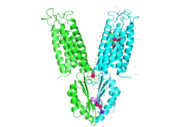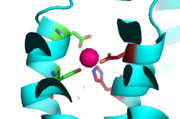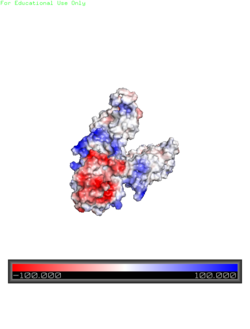Sandbox Reserved 1069
From Proteopedia
| Line 11: | Line 11: | ||
YiiP has a "Y" shape <scene name='75/756372/Newmainpic/1'> conformation</scene> with two different functional conformations. A total of six helices comprise the transmembrane portion of each <scene name='75/756372/Sixhelices/1'>protomer</scene>. Four of these helices are bundled together while the remaining two are oriented antiparallel to the <scene name='75/756372/2antiparallel/1'>bundle</scene>. Movement of these helices play a role in the function of YiiP. An interlocked salt bridge connects the two domains with the Lys77 and the Asp207 from each protomer - visualized <scene name='75/756372/Saltbridgeclose/1'>here</scene>.This [https://en.wikipedia.org/wiki/Salt_bridge_(protein_and_supramolecular) salt bridge] acts as the hinge for the conformational changes that YiiP undergoes. YiiP has three zinc binding sites, two of which are known to play an active role in the function of YiiP. Site A (link) sits in extracellular space outside of the cell, while site C is situated inside of the cell to act as a sensor of intracellular zinc concentrations. | YiiP has a "Y" shape <scene name='75/756372/Newmainpic/1'> conformation</scene> with two different functional conformations. A total of six helices comprise the transmembrane portion of each <scene name='75/756372/Sixhelices/1'>protomer</scene>. Four of these helices are bundled together while the remaining two are oriented antiparallel to the <scene name='75/756372/2antiparallel/1'>bundle</scene>. Movement of these helices play a role in the function of YiiP. An interlocked salt bridge connects the two domains with the Lys77 and the Asp207 from each protomer - visualized <scene name='75/756372/Saltbridgeclose/1'>here</scene>.This [https://en.wikipedia.org/wiki/Salt_bridge_(protein_and_supramolecular) salt bridge] acts as the hinge for the conformational changes that YiiP undergoes. YiiP has three zinc binding sites, two of which are known to play an active role in the function of YiiP. Site A (link) sits in extracellular space outside of the cell, while site C is situated inside of the cell to act as a sensor of intracellular zinc concentrations. | ||
| - | |||
| - | |||
===Interlocking Salt Bridge=== | ===Interlocking Salt Bridge=== | ||
The salt bridge formation between Lys77 and Asp207 of each domain of YiiP form an interlocking salt bridge that acts as the pivot point of the conformational change that drives the function of YiiP. The salt bridge is disrupted when Zinc is bound, due to movement of the antiparallel helices. This disrupts the ion-ion attractions that established the salt bridge- causing a conformational shift in YiiP. This salt bridge also aids in holding the two protomers together. [[Image:Saltbridge.png|200px|left|thumb|Lys77 and Asp207 Salt Bridges]]<scene name='75/756372/Hydrophobic1/1'>Hydrophobic</scene> residues beneath the salt bridge further stabilize the two domains in the v-shaped void where the domains connect. This prevents degradation of the protein's interlock via interactions with the environment. | The salt bridge formation between Lys77 and Asp207 of each domain of YiiP form an interlocking salt bridge that acts as the pivot point of the conformational change that drives the function of YiiP. The salt bridge is disrupted when Zinc is bound, due to movement of the antiparallel helices. This disrupts the ion-ion attractions that established the salt bridge- causing a conformational shift in YiiP. This salt bridge also aids in holding the two protomers together. [[Image:Saltbridge.png|200px|left|thumb|Lys77 and Asp207 Salt Bridges]]<scene name='75/756372/Hydrophobic1/1'>Hydrophobic</scene> residues beneath the salt bridge further stabilize the two domains in the v-shaped void where the domains connect. This prevents degradation of the protein's interlock via interactions with the environment. | ||
| - | |||
=== Zinc Binding Sites === | === Zinc Binding Sites === | ||
[[Image:full_view.png|thumb|left|]] | [[Image:full_view.png|thumb|left|]] | ||
Each zinc promoter contains three zinc binding sites. There is an active site (Site A), and two cytoplasmic binding sites (Site B and C). It was found that only site A and C are conserved, while the function of Site B is still unknown, though it seems to play a role in subunit dimerization. | Each zinc promoter contains three zinc binding sites. There is an active site (Site A), and two cytoplasmic binding sites (Site B and C). It was found that only site A and C are conserved, while the function of Site B is still unknown, though it seems to play a role in subunit dimerization. | ||
| - | |||
'''Binding Site A''' | '''Binding Site A''' | ||
| Line 30: | Line 26: | ||
It is important to note that the structure of this binding site is rigid because of the coordination of the zinc between the four residues. This rigidity is indicative that any slight shift on either of the helices will cause a drastic readjustment of the coordination of zinc. In addition, there are no outer-shell constraints to hold the residues in place, which means that with a readjustment of the molecule, there is no energy being expended to bind or release another zinc molecule. Therefore, the zinc is able to rapidly release and a new zinc can bind again with a simple reorientation or shift of the molecule. This rapid on off bind and release mechanism is the regulator of homeostatic levels of zinc in the cell. This regulation is so rapid in fact, it is significantly faster than other zinc exchange rate proteins- by several orders of magnitude. | It is important to note that the structure of this binding site is rigid because of the coordination of the zinc between the four residues. This rigidity is indicative that any slight shift on either of the helices will cause a drastic readjustment of the coordination of zinc. In addition, there are no outer-shell constraints to hold the residues in place, which means that with a readjustment of the molecule, there is no energy being expended to bind or release another zinc molecule. Therefore, the zinc is able to rapidly release and a new zinc can bind again with a simple reorientation or shift of the molecule. This rapid on off bind and release mechanism is the regulator of homeostatic levels of zinc in the cell. This regulation is so rapid in fact, it is significantly faster than other zinc exchange rate proteins- by several orders of magnitude. | ||
| - | |||
'''Binding Site C''' | '''Binding Site C''' | ||
<scene name='69/694236/Site_c/1'>Binding Site C</scene> has vastly opposite properties from what is seen in binding site A. It is located on the TM2-TM3 loop on the cytoplasmic membrane and between the two C-terminus domain interfaces. Here, there is a binuclear coordination of zinc between the <scene name='69/694236/Asp285/3'>Asp285</scene> residue that bridges the zinc ions together and the four coordinating residues (His232, His248, His283 and His261). The Asp285 residue is conserved, meaning it does not have outer shell constraints. However, the four histidine residues all have outer shell constraints. These constraints consist of hydrogen bonds to the residues surrounding the binding site. These hydrogen bonds can form bidentate bonds, which means that the hydrogen bond attaches to a metal in two places. These bonds in turn create an extensive network of interactions at the CTD interface, and it is these interactions that allow for stability and strengthening of the CTD-CTD association. | <scene name='69/694236/Site_c/1'>Binding Site C</scene> has vastly opposite properties from what is seen in binding site A. It is located on the TM2-TM3 loop on the cytoplasmic membrane and between the two C-terminus domain interfaces. Here, there is a binuclear coordination of zinc between the <scene name='69/694236/Asp285/3'>Asp285</scene> residue that bridges the zinc ions together and the four coordinating residues (His232, His248, His283 and His261). The Asp285 residue is conserved, meaning it does not have outer shell constraints. However, the four histidine residues all have outer shell constraints. These constraints consist of hydrogen bonds to the residues surrounding the binding site. These hydrogen bonds can form bidentate bonds, which means that the hydrogen bond attaches to a metal in two places. These bonds in turn create an extensive network of interactions at the CTD interface, and it is these interactions that allow for stability and strengthening of the CTD-CTD association. | ||
| + | |||
| + | == Electrostatic Interactions == | ||
| + | [[Image:Yiip_Electrostatic.png|250px|left|thumb|Electrostatic Charge Distribution]]<scene name='69/694234/Electro/1'>Charge distribution</scene> along the exterior surface of the protein is primarily neutral for the TMDs, but transitions to positive near the location of the charge interlock and interior side of the cell membrane. This positive section is characteristic of trans-membrane proteins as a means of achieving proper orientation within the cell membrane. Binding sites A, B, and C, as well as the CTDs of both monomers, all possess a high negative charge relative to the other charges present, facilitating the binding and releasing of Zn<sup>2+</sup> ions. The two CTDs are held together by the charge interlock and hydrophobic interactions of the TMDs despite their electrostatic repulsion. Upon the release of Zn<sup>2+</sup> ions, the CTDs undergo electronegativity alterations, which enables domain separation. | ||
==Zn<sup>2+</sup> Induced Conformation Change== | ==Zn<sup>2+</sup> Induced Conformation Change== | ||
| Line 45: | Line 43: | ||
YiiP's ability to export Zn<sup>2+</sup> from the cytoplasm is best described as an alternating access mechanism with Zn<sup>2+</sup>/H<sup>+</sup> antiport. YiiP has 2 major structural conformations as shown by the crystallized structures [[3H90]] and [[3J1Z]] (a YiiP homolog derived from ''Shewanella oneidensis''). 3H90 shows YiiP in its outward-facing conformation and 3J1Z shows the YiiP homolog in an inward-facing conformation. | YiiP's ability to export Zn<sup>2+</sup> from the cytoplasm is best described as an alternating access mechanism with Zn<sup>2+</sup>/H<sup>+</sup> antiport. YiiP has 2 major structural conformations as shown by the crystallized structures [[3H90]] and [[3J1Z]] (a YiiP homolog derived from ''Shewanella oneidensis''). 3H90 shows YiiP in its outward-facing conformation and 3J1Z shows the YiiP homolog in an inward-facing conformation. | ||
When YiiP is saturated with Zn<sup>2+</sup> it seems to favor the perplasmic/outward-facing conformation whereas when active sites are either empty or bound to H<sup>+</sup> the inward facing conformation is favored. This drives the export of Zn<sup>2+</sup> from the cytoplasm and enhances the coupling of the proton-motive force. Although YiiP exists as a homodimer both monomers can undergo conformation change independent of one other to produce the alternating access mechanism. | When YiiP is saturated with Zn<sup>2+</sup> it seems to favor the perplasmic/outward-facing conformation whereas when active sites are either empty or bound to H<sup>+</sup> the inward facing conformation is favored. This drives the export of Zn<sup>2+</sup> from the cytoplasm and enhances the coupling of the proton-motive force. Although YiiP exists as a homodimer both monomers can undergo conformation change independent of one other to produce the alternating access mechanism. | ||
| - | |||
| - | == Electrostatic Interactions == | ||
| - | [[Image:Yiip_Electrostatic.png|250px|left|thumb|Electrostatic Charge Distribution]]<scene name='69/694234/Electro/1'>Charge distribution</scene> along the exterior surface of the protein is primarily neutral for the TMDs, but transitions to positive near the location of the charge interlock and interior side of the cell membrane. This positive section is characteristic of trans-membrane proteins as a means of achieving proper orientation within the cell membrane. Binding sites A, B, and C, as well as the CTDs of both monomers, all possess a high negative charge relative to the other charges present, facilitating the binding and releasing of Zn<sup>2+</sup> ions. The two CTDs are held together by the charge interlock and hydrophobic interactions of the TMDs despite their electrostatic repulsion. Upon the release of Zn<sup>2+</sup> ions, the CTDs undergo electronegativity alterations, which enables domain separation. | ||
| - | |||
== References == | == References == | ||
<references/> | <references/> | ||
Revision as of 21:24, 29 March 2017
Introduction
Zinc transporter is an integral membrane protein found in the membrane of Esherichia coli. YiiP is a member of the cation diffusion facilitator family. Members of this family occur all throughout the biological realm. These diffusion facilitators export divalent transition metal ions from the cytoplasm to the extracellular space [1]. They work to regulate the amount of divalent metals inside of the cell, which is biologically relevant because while these metals are necessary for different biological functions, they can prove fatal to the cell in excess amounts. Zinc is essential for the growth and development of cells and zinc levels can affect everything from gene expression to immune response. While YiiP is an integral membrane protein in the cells of Escherichia coli, understanding the mechanism of regulation behind it can help researcher's better understand the cation diffusion facilitator equivalents in eukaryotic cells.
| |||||||||||




